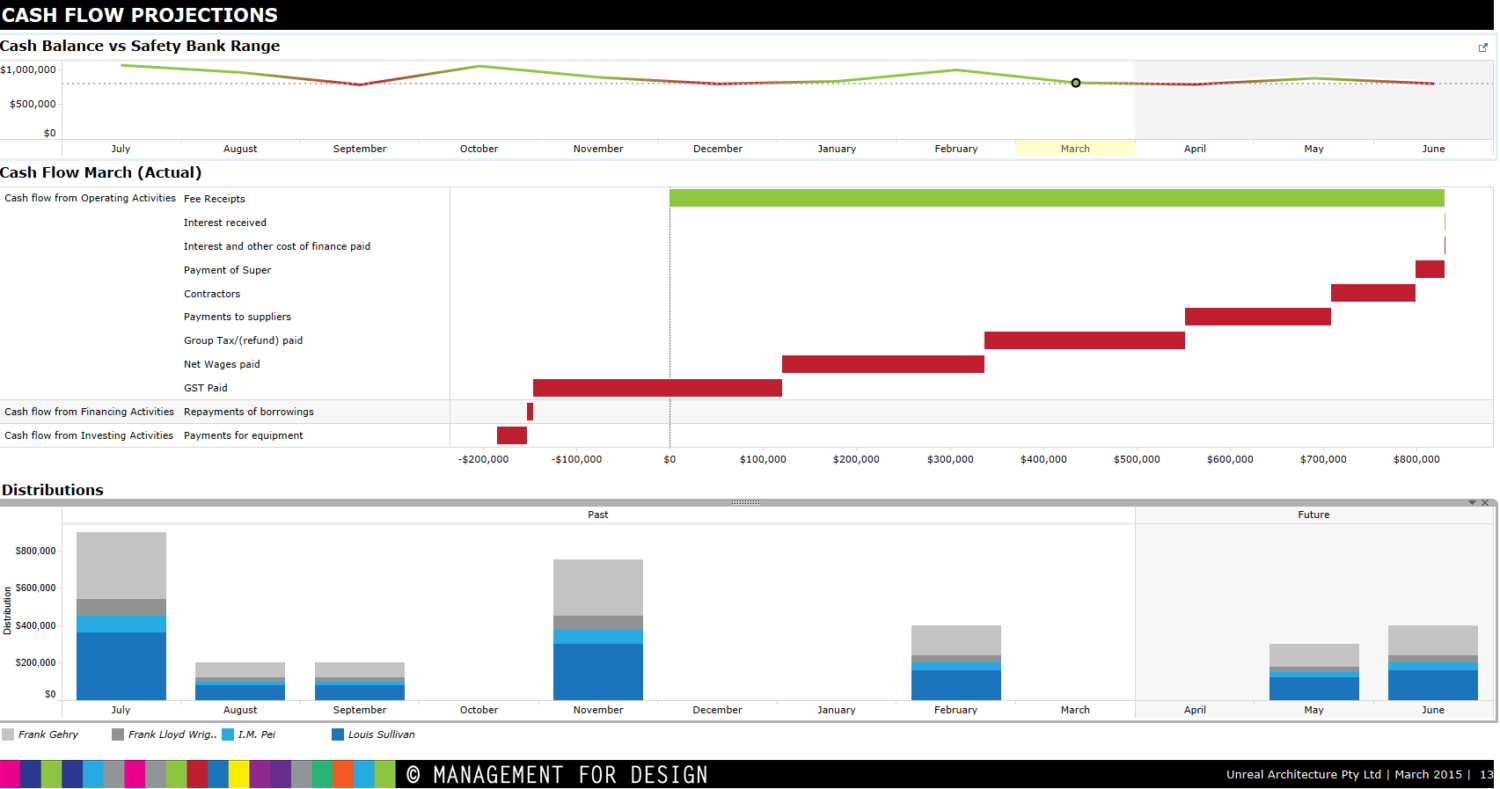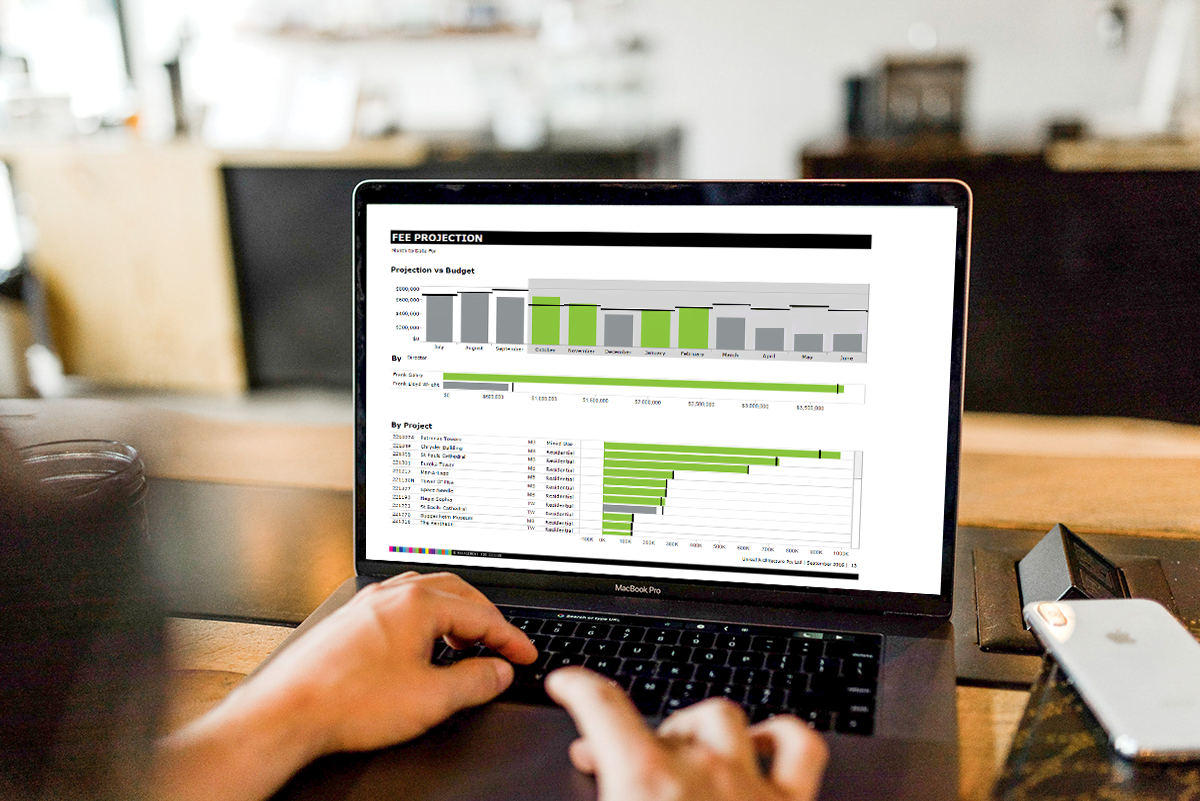Management for Design Founding Director Gordana Blazevska takes us through the basics, from cash flow and balance sheets to profit margins and transparency.

Knowing where your practice stands financially is fundamental to effective decision making. Where are the numbers today and where should they be in the future? How do you drive your practice to succeed and deliver the outcomes that you are seeking?
Often it is the business leaders who will set the financial structures in place and champion them, but it’s up to everyone in the business to understand what they are, why they are there, and the impact each person has on them.
Accessing accurate and timely information is not always easy. There is the income, expenses, profit margin, cash position, project performance, etc. And once you have all this information, you then need to interpret and understand it.
If you are a leader, it’s your role to regularly absorb this information and to make decisions promptly. These executive decisions can then be converted into activities to be completed by your team.
As part of the team, either as one of the leaders or as an employee, it’s important to understand everything you do has an impact on the financial performance of the practice, and you need to remain cognisant of this. You can exercise care around these areas, even if you are not directly responsible for them.
So, what are the fundamental financial structures, behaviours and understandings that need to be in place for your practice to be successful?
Understanding the difference between profitability & cash flow
First things first – profit and cash are different. Profit is the practice’s earnings (revenue) minus the expenses (which are the costs that the business incurs to generate the revenue). Profit is, simply put, ‘a theory’ – because you can’t spend it. On the other hand, cash is the money the practice has in its bank account. This is real and can be spent.
Each business transaction will affect the profit and cash in different ways – and at different times. For example, paying salaries and wages, paying tax, purchasing computers and equipment, waiting on debtors to make a payment, or the creditors that haven’t been paid yet – all of these situations will affect the profit and cash position differently.
Most of the time, the effect on the cash position can be delayed and occurs after the change in your profit position. For example, say your fees for June were $500,000. By mid-July you are unlikely to have received any of the $500,000 that’s reported in your profit and loss statement. On the flip side, those salaries and wages incurred to produce the $500,000 worth of fees – say that equates to $250,000 including on-costs – would have already been paid by now, and have reduced your bank account accordingly. Both are important to your business and need to be reviewed every month (as a minimum).

The amount of money businesses should have access to in the bank
The amount of money needed in the bank account will often depend on the risk profile and the life stage of the practice.
Most start-ups will routinely have to add additional funds, whereas established businesses may retain years’ worth of unpaid profits ‘in case of a rainy day’. Or, if they are in expansion mode, the business could even be tapping into an overdraft facility.
As a benchmark, a practice should aim for one to three months’ worth of average monthly expenses. More than this just means the business owes the owners money. Anything less than a month’s worth of expenses – unless there is a bank overdraft facility – could mean that cash flow is distracting the practice leaders, creating unnecessary concerns and pressure.
Right now, in this COVID-19 environment, most practices will be happy with four to six weeks’ worth of expenses in the bank.
The difference between income statements and balance sheets
An income statement or profit and loss statement are fundamental to understanding and assessing the performance of your practice. This keeps track of the income (fees) and expenses (the costs that your practice incurs to generate those fees). The difference between the two is the profit, provided that the fees are more than the costs; otherwise, this is a loss. Just being aware of this simple calculation can help every team member to benefit the practice.
The numbers are always a reflection of the decisions that were or were not made, and the resulting activities during the month. So, doesn’t it stand to reason that if we want to change the numbers, we simply need to change the activities that caused the numbers?
A balance sheet is simply a measure of ‘what the practice owns’ and ‘what the practice owes’ at a specific moment in time.
Both reports are necessary and should be reviewed monthly. We often say, what you measure is what you monitor and manage. Month in month out, the practice leaders need to know where the business stands financially, to enable them to steer it in the right direction.
Knowing what the firm’s profit margin is and where it should be
Profit divided by fees is referred to as the profit margin. And a well-run practice will have a profit margin above 20%. In professional services a significant portion of the expenses are salaries – if they are less than 50% of the total fees, then a profit margin of 20% should be achievable.
A profit margin between 10% and 20% is acceptable; however, this doesn’t leave much room for low fee months.
A profit margin above 30% may mean the practice is an expert in its niche and can command significant fees, or maybe just that your people are overworked and under-rewarded.

Having budgets and forecasts in place
A budget sets the tone for the year ahead and encapsulates the strategy for the practice in numbers. In setting a budget, a practice is putting a benchmark in place of the expected work.
Budgets should be set annually and then reviewed monthly – typically at the start of the new financial year. This is essential for forward forecasting and where you think the practice will be in 12 months.
Some of the considerations when setting a budget should be:
- Work generated
- Work in hand
- Number of people
- Cost of people
- Cost of overheads
- Current opportunities
Even if you’re not a practice leader, it’s still important to understand the effect you have on budgets.
A forecast is derived from reviewing the budget monthly and having a clear understanding of where the practice is now and where it is heading – this is very important right now. This should be updated as new information comes to hand. Rather than alter the budget, we capture this in a forecast.
Reviewing budget variances
A budget variance is a difference between a budgeted amount – revenue and expenses – and the actual amount. The budget variance is favourable when the actual revenue is higher than the budget or when the actual expense is less than the budget.
Typical budget variances are usually caused by changes in revenue (like the fees going up or down) or not managing expenses accordingly, which can sometimes be due to inaccurate assumptions or poor budgeting, and means results are measured against an unreasonable baseline.
Variances between actual and budgeted numbers should be investigated and explained monthly.
Ideally, unfavourable variances should be avoided wherever possible, as these could negatively impact the performance of the practice.
Project profitability
First of all, we recommend that practices have project reporting in place. It is important to track fees and costs by project to ensure that projects can be completed within their set budgets and stay profitable.
The culmination of the profit of each project makes up the overall financial performance of the practice.
Only when the practice has established the profitability of each of the practice’s projects can it make accurate decisions about resourcing and fees.
Knowing what financial information to share with your leadership team
While every business is different, it is fundamental for the team to have access to the information they require to excel in their role.
This means different things to different practices – some will share all financial information and others limited. Leaders will share what they feel comfortable with, while ensuring the necessary information is made available to the team to drive the practice forward and ensure good decision making.
There is also an opportunity for the business to mentor its leaders and support them to make informed business decisions.
Setting and reviewing meaningful Key Performance Indicators (KPIs)
How can you ensure everyone is doing their part to help the practice succeed? We recommend that every practice sets and reviews meaningful KPIs every month.
What gets measured can be managed and can grow exponentially.
Some KPIs the practice may want to consider include:
- Profit margin
- Debtor days
- Fees per person
- Costs per person
- Work generated
- Staff utilisation

Working with an accountant to optimise performance
We recommend that practices either work with an external accountant monthly or hire a CFO or Head of Finance internally.
The language of business is accounting and unless you are well versed in it, you are dabbling! Some owners will have copious amounts of reports and yet they have no idea how to read them, interpret them, or understand them. Most leaders generally have enough to do between generating new work, designing, and ensuring existing projects are on track. The practice needs to put an expert in charge of this area.
By outsourcing the accounting function to a specialist service partner, the business can focus its attention on other key areas that directly impact its profitability. This will free up the directors to lead with confidence in a competitive market, with the knowledge that the finances are in safe hands.
Becoming financially literate
All architects need to understand how the finances affect the business, with the level of understanding required dependent on their level within the practice. For example, if you’re a graduate architect, it’s important to have an understanding of how getting your timesheet in on time can lead to effective decision making. If you’re a senior architect, you need an understanding of the current profitability of your project and how you can improve or maintain it. An associate should be across multiple projects, including the fees, how hours are tracking, the profitability, scope creep, etc.
Architecture is a business, and the more architects can make a connection between the design process and the numbers, the better placed they will be to help the practice, rather than hinder it, so that the business can take on larger and more ambitious projects.
If you are a director or a business leader, having a solid understanding of the current practice finances and position will give you peace of mind, and the confidence to focus on other aspects of your business.
Watch Gordana discuss Financial Literacy as part of the Light at the End of Tunnel series.
Gordana Blazevska is a founding director of Management for Design, where she applies her valuable skills as a CPA to enhance the business efficiency and performance of architects, engineers and design businesses. With over 25 years of experience, Gordana has built her expertise through broad practice in accounting and financial control in a range of industries, including design, hospitality, retail, security and investigation, and fashion.




















